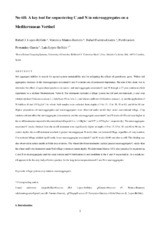Mostrar el registro sencillo del ítem
No-till: a key tool for sequestering C and N in microaggregates on a Mediterranean Vertisol
| dc.contributor.author | López-Bellido Garrido, Rafael J. | |
| dc.contributor.author | Muñoz-Romero, Verónica | |
| dc.contributor.author | Fuentes-Guerra, Rafael | |
| dc.contributor.author | Fernández García, María Purificación | |
| dc.contributor.author | López Bellido, Luis | |
| dc.date.accessioned | 2024-01-10T12:43:20Z | |
| dc.date.available | 2024-01-10T12:43:20Z | |
| dc.date.issued | 2017 | |
| dc.identifier.issn | 1879-3444 | |
| dc.identifier.uri | http://hdl.handle.net/10396/26480 | |
| dc.description.abstract | Soil aggregate stability is crucial for agroecosystem sustainability and for mitigating the effects of greenhouse gases. Within soil aggregates, increases in the microaggregate-associated C and N contents are of paramount importance. The aim of this study was to determine the effect of agricultural practices on macro- and microaggregate-associated C and N through a 27-year continuous field experiment in a dryland Mediterranean Vertisol. The treatments included a tillage system (no-till and conventional), 2-year crop rotations [wheat (Triticum aestivum L.)-faba bean (Vicia faba L.) and wheat-sunflower (Helianthus annuus L.)], and the application of N fertilizer (0 and 100 kg ha−1) to wheat. Soil samples were collected from depths of 0 to 15, 15 to 30, 30 to 60, and 60 to 90 cm. Higher proportions of microaggregates and macroaggregates were observed under no-till than under conventional tillage. Crop rotations did not affect the microaggregate concentration, and the microaggregate-associated C and N stocks (0–90 cm) were higher in the no-till treatment compared with conventional tillage (6.9 vs. 4.4 Mg ha−1 and 957 vs. 672 kg ha−1, respectively). The microaggregate-associated C stocks obtained from the no-till treatment were significantly higher at depths of 0–15, 15–30, and 60–90 cm. At certain depths, the no-till treatment resulted in greater microaggregate N stocks than conventional tillage, regardless of crop rotation. Conventional tillage yielded significantly lower macroaggregate-associated C and N stocks (0–90 cm) than no-till. This finding was also observed at certain depths in both crop rotations. The wheat-faba bean treatments yielded greater macroaggregate C stocks than the wheat-sunflower treatments under both tillage systems at certain depths. We determined that no-till is a key practice for sequestering C and N in microaggregates and that crop rotation and N fertilization do not contribute to the C and N sequestration. As a result, no-till appears to be the only truly effective practice for the long-term encapsulation of C and N in microaggregates. | es_ES |
| dc.format.mimetype | application/pdf | es_ES |
| dc.language.iso | eng | es_ES |
| dc.publisher | Science Direct | es_ES |
| dc.rights | https://creativecommons.org/licenses/by-nc-nd/4.0/ | es_ES |
| dc.source | Soil & Tillage Research; 166, 131–137 (2017) | es_ES |
| dc.subject | Tillage system | es_ES |
| dc.subject | Crop rotation | es_ES |
| dc.subject | Macroaggregates | es_ES |
| dc.title | No-till: a key tool for sequestering C and N in microaggregates on a Mediterranean Vertisol | es_ES |
| dc.type | info:eu-repo/semantics/article | es_ES |
| dc.relation.publisherversion | https://doi.org/10.1016/j.still.2016.09.012 | es_ES |
| dc.relation.projectID | Gobierno de España. AGL2015-65548-R | es_ES |
| dc.rights.accessRights | info:eu-repo/semantics/openAccess | es_ES |

